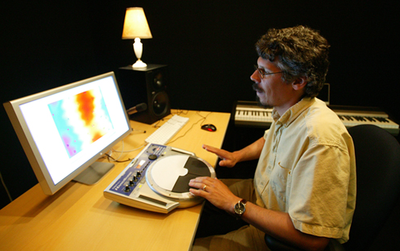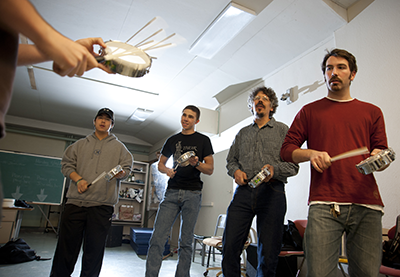Petr Janata: In the Groove
Music, as the soundtrack to our everyday experience, can make us feel and remember powerful things. But how and why it can do this is still not well understood.
These are the questions psychology professor Petr Janata tries to answer. Janata studies how the brain interacts with music, including how it represents musical structure, which areas are stimulated by music, and what happens when a person really connects with a song.
“I’m fascinated by the human brain and really want to understand how it works,” he said, “and I think music serves as an excellent model system for understanding the brain.”
He has wild, gray and black hair, glasses, and a moustache and goatee, looking appropriately like a cross between a stereotypical symphony conductor and a classic scientist. Yet he is friendly and laid-back, dressed in a T-shirt and shorts and casually sipping coffee while explaining complex topics.
Janata first made the connection between music and the brain in a cognitive psychology class as an undergraduate student at Reed College. When he learned how the brain represents the structure in our environments, he thought of the music theory he had learned from taking piano lessons from childhood through high school.
“It occurred to me that music is just a really beautiful system for setting up expectations of varying degrees. Why do we detect something as a wrong note in the first place? It means our brains have some representation of the context, and that context is predicting that some notes are more likely to occur than others. So thinking about those things [means] realizing that music could be used to study very fundamental psychological and neural processes,” he said.
Janata’s experiments take place in two rooms inside a larger room at the Center for Mind and Brain. Between these two rooms is a large desk with computer monitors, a sound machine, and speakers used to record the data. At any time, he has five to six graduate students plus a number of undergraduate research assistants working on various projects.
He has three different areas of research:
How the Brain Follows Music Moving in Tonal Space: Tonal space is the system of major and minor keys in music that shows how close they are from each another and how they work together to create sound. Janata identified the region of the brain that tracks this, and used functional neuroimaging to show the brain following a piece of music as it played. The study, probably his most famous, was published in Science in 2002, and was featured in Scientific American and on CNN.
Music-Evoked Remembering: This is the sensation of nostalgia people get when hearing a song. Janata found that the part of the brain linked to memories and emotions is stimulated when hearing familiar music. He is now studying how music becomes linked with memories, theorizing that having music stuck a person’s head strengthens the memory of the music and memories associated with it.
“People understand that connection with music in a very intuitive way, so to be able to do some of the first studies on that was pretty meaningful,” he said. The research was inspired by the knowledge that music provokes strong responses from people with Alzheimer’s disease and can be used as therapy for the condition. He says his work on the topic fueled public interest in it.
He has launched and continues to refine a website called MEAMCentral, where people can share memories they associate with different pieces of music. He hopes to create a meaningful social environment while collecting data about musical memories.
Being “In the Groove”: “The Groove Project,” looks at what goes on in the brain when someone gets “in the groove” of a song. He wants to understand how people get in the groove and why the experience is so pleasurable. They hope to see whether being in the groove can promote cooperation among small groups of people.
Janata received a Guggenheim Fellowship for his work in 2010. He is serving as a member of the Society for Music Perception and Cognition’s executive board for the second time, and he is also an ad hoc reviewer for many academic journals and international funding agencies.
Janata joined UC Davis in 2004, shortly after the Center for Mind and Brain was established. He teaches “The Psychology of Music” (PSC 136) and “Cognitive Neuroscience” (PSC 135) for undergraduates, and “Programming in MATLAB” (PSC 209A) for graduate students. He said he loves interacting with his graduate students and helping them work through the process of designing experiments and analyzing data. “I always find that to be really gratifying,” he said.
In his free time, he plays keyboard in a couple of local folk rock bands and is learning to play organ. “I love that sort of interaction,” he said. “It’s just really creative.”
He also enjoys skiing and being outdoors and said he feels lucky to be in Northern California. “The Center [for Mind and Brain]’s been great, the Department of Psychology is really good, and Davis is a nice place to live,” he said.
— Noah Pflueger-Peters (B.A., English, ’17)
